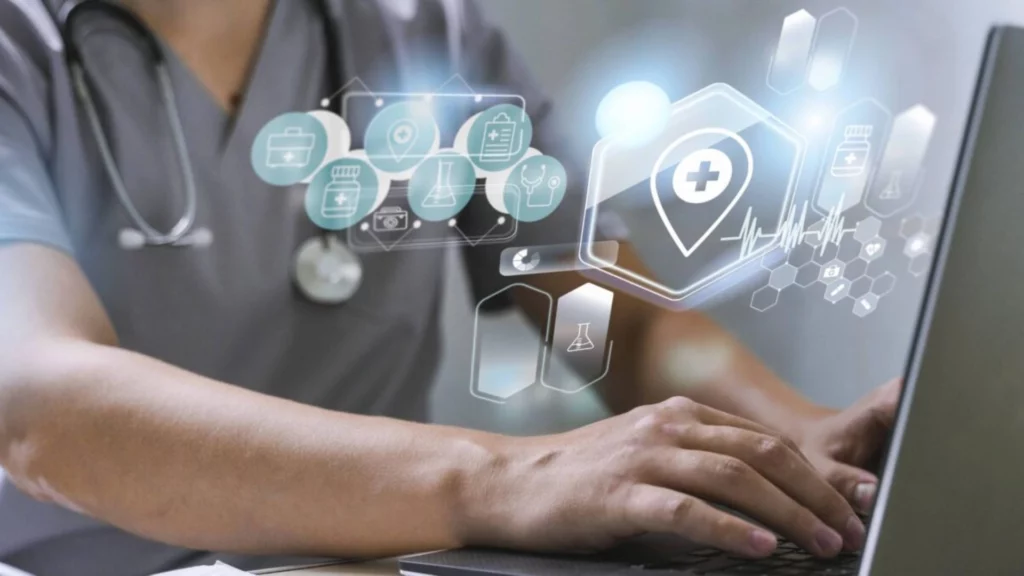The Benefits Of Healthcare Data Analytics For Outpatient Clinics

Patient Experience: using data analytics and business intelligence to improve patient loyalty and satisfaction scores (NPS, CSAT, and AHT).
Healthcare Analytics – What Is It?
A key shared concern among healthcare practitioners and outpatient clinics is how to improve patient positive outcomes at the lowest cost. The vast majority of the healthcare system is moving from a fragmented services’ profitability-centric approach to a patient-centric, also known as the patient satisfaction approach, where the most important thing is to provide a value-based healthcare system.
However, ballooning healthcare costs and the need to prioritize healthcare staff well-being have always been a concern and, in a way, an obstacle to achieving value-driven healthcare. Healthcare staff burnout has been on the rise, even before covid times. For example, studies show that 37-49% of healthcare workers suffer from emotional exhaustion (EE) compared to a mere 19-30 percent among employees working in other sectors.
In the early days of the COVID-19 outbreak, healthcare costs in the US rose rapidly by 9.7 percent, summing to a rough estimate of $4,124 billion in 2020.
Fortunately, healthcare data analytics proved to be a solution to this problem. Healthcare analytics is not a new term, it’s been around for a long time in the industry. Analytics can help with many things, such as prioritizing care for specific individuals, identifying clinics and patients’ needs and gaps, making better treatment decisions, developing new strategies to reduce costs, or promoting healthcare staff welfare.
Healthcare data analytics is the process of using data analysis and data science techniques to make data-driven decisions and improve processes and operations at healthcare facilities, outpatient centers, and clinics. By understanding patterns in patient data, outpatient centers can identify areas for improvement, allocate resources more effectively, and monitor results.
Data analytics can also help identify new sources of revenue, profit, and savings through optimized resource allocation and spending.
Where Can You Gather Healthcare Data?
There are numerous sources of healthcare data that can be utilized in analytics. Here, we will share six of the most common and reliable sources to start your analytics journey:
1. Customer Satisfaction Scores (CSAT)
CSAT is the most straightforward customer success metric. Hospitals and outpatient centers use CSAT to measure patient satisfaction levels and identify areas where improvement in service and interaction with patients is necessary.
How to calculate the CSAT?
To calculate CSAT, take all your survey responses rated as “satisfied” or positive responses, according to your survey parameters, divide it by the total number of responses you received and multiply by 100. Usually, CSAT is measured on a scale of five points, ranging from “very unsatisfied” to “very satisfied”, you can check the Healthcare customer satisfaction index to benchmark your clinic’s CSAT.
2. Clinic Average Handle Time (AHT)
Clinic average handle time measures the average amount of time it takes for a clinic contact center to process a new patient. With AHT healthcare facilities and hospitals can track trends over time, and identify areas where they are performing better or worse than average, as well as seasonalities. Your AHT includes any hold times, transfers, conversations, and follow-up work after the call.
3. Net Promoter Score (NPS)
The Net Promoter Score (NPS) is a widely used metric to track customer loyalty and satisfaction. The NPS score is commonly measured on a scale of ten points and it can be determined by subtracting the percentage of customers who scored “negative” from the percentage of customers who scored “positive.”
Next, divide the result by the total number of customers. The more positive the NPS score, the more loyal and satisfied your patients are with your service and interaction with your clinic.
4. Electronic Health Record Systems (EHRS)
EHRS contains detailed information on a patient’s medical records, medications, imaging reports, tests and laboratory results, and other health-related data shared among multiple facilities. This data can be used to identify trends in illnesses and improve your patient care and diagnosis.
5. Customer Feedback
You can gather your patient’s feedback through various methods, including surveys, focus groups, and interviews. Healthcare analytics can help identify which patients are experiencing problems, what these problems are, and how best to address them.
A wealth of patient insights and data is available online. For example, PatientsLikeMe, a social network for patients, allows users to create communities and share their health journey, diagnosis, and experiences with hospitals and doctors. This information can help healthcare providers identify areas where they need to improve their services.
6. Enterprise Resource Planning Software for Healthcare Providers (ERPS)
ERPS contains detailed information on patient care, staff performance, and resource allocation. This data can be used to make important decisions about how to improve healthcare delivery, and it can also help to identify areas where improvement is needed.
Benefits of Healthcare Analytics
Healthcare data analytics can improve the efficiency and quality of outpatient clinic services by providing insights not only into patient interactions but also into terms of workforce, facilities, and budget management. By understanding how all of these factors come into play together and relate to one another, clinics can make better and more informed decisions when allocating human and monetary resources to improve the overall patient experience.
The benefits of applied analytics to healthcare outpatient centers and clinics are countless, but here are the main ones:
Enhanced and Automatize The Ability To Identify Problems and Create An Effective Action Plan For Improvement
In most organizations, resolving a problem typically involves an eight-step process. Out of eight, four are dedicated to defining the problem and breaking it down into manageable steps.
However, when this process is done manually, it’s time and resource-consuming, this is where data analytics and data science are most effective. Healthcare data analytics powered by big data can do all of this more accurately, in significantly less time, with less resource requirement, and available adequate data, incredible results can be achieved.
Aside from identifying the problems at your healthcare facilities, data analytics can be used to test different hypotheses and solutions to solve those problems quickly.
For instance, by correctly determining which patients are visiting the clinic more often for respiratory issues, clinics may be able to provide more targeted respiratory therapy.
By understanding what drives these visits, clinics can better target their marketing efforts.
Similarly, by diving deep into patient data and staff schedules, clinics can better optimize appointment scheduling for patients.
Helps To Keep A Pulse Check On Staff
By gathering data on employee activity, hospital administrators can identify areas of improvement and make necessary adjustments to the clinic’s operating procedures.
In turn, this helps to improve patient care and employee satisfaction. Additionally, by understanding how employees spend their time, clinics can determine better ways to schedule their shifts for better welfare.
Improved Patient Outcomes
Data analytics and business intelligence tools can help clinicians and healthcare providers to identify patterns in patient data and make better decisions about treatments. For instance, suppose nurses notice that a certain type of medication is often prescribed to patients experiencing a particular health issue, in that case, they may recommend that medication be available in major quantities to prescribe it more frequently.
Better Resource Utilization and Revenue Collection
Data analytics provides clinics and hospitals with an overview of their patient’s medical history and current treatment plans.
The use of big data analytics can help identify patterns in patient behavior that may indicate a need for preventative care or early intervention. By understanding patient demographics and their specific health needs and records, outpatient clinics can provide better care and save money in the long run.
Similarly, big data analytics solutions can provide more insights to outpatient healthcare facilities on the effectiveness of their resource allocation, revenue collection, and the resultant return on investment (ROI).
Based on this, clinic administrators can formulate more effective plans that maximize ROI while prioritizing patient outcomes and staff welfare.
CCD’s Healthcare Analytics Process
CCD’s healthcare analytics process is the most comprehensive solution for outpatient healthcare facilities. CCD Health can help unleash your practice potential, engaging your patients and enhancing their experience through solutions driven by patient scheduling data analytics and interactions provided by a tailor-made healthcare-specialized workforce.
Key features of CCD’s data analytics comprehensive process include:
- Defining the required use-case
- Creating a hypothesis
- Determining data needs
- Collecting the required data
- Forming conclusions and developing effective and actionable recommendations.
Work With CCD Health Data Analytics Experts
Despite the many benefits, data analytics and data science is still highly technical discipline that requires skilled and experienced professionals.
Partner with the #1 rated Patient Scheduling Service for U.S. Radiology Centers and experience the benefits of top-tier healthcare data analytics and reporting for healthcare.
Our refined and tested processes and helpful customer success specialists are ready to help you improve and scale your healthcare business.
Contact us for more information.






